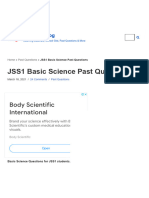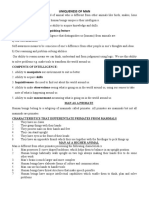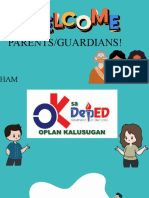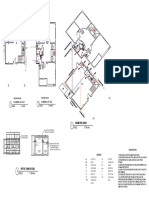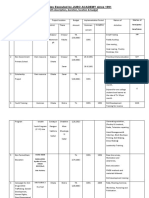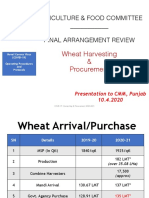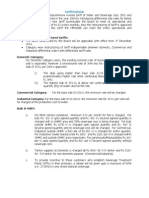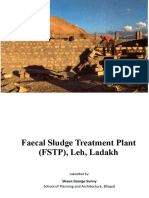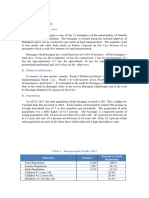Basic Science and Technology PDF
Uploaded by
promiseisemin59Basic Science and Technology PDF
Uploaded by
promiseisemin59Cambridge University Press
978-1-108-78938-7 — NEW Excellence in Basic Science and Technology JSS1 Student Book Blended with Cambridge Elevate
Elizabeth Ritchie , Cheryl Thomas , Peter Holmes , Annette Koch , Helen Collett
Excerpt
More Information
SECTION
1 Basic science
Theme 1: Learning about our environment
Topic 1: Family health
Topic 2: Environmental pollution
Topic 3: Living and non-living things
Theme 2: Human development and
reproduction
Topic 4: Human development
Basic Topic 5: The reproductive system
science Topic 6: Human reproduction (i)
Topic 7: Human reproduction (ii)
Topic 8: HIV/AIDS
Theme 3: You and energy
Topic 9: Energy
Topic 10: Renewable and non-renewable energy
Topic 11: Forces
Theme 4: Science and development
Topic 12: The Earth in space
© in this web service Cambridge University Press www.cambridge.org
Cambridge University Press
978-1-108-78938-7 — NEW Excellence in Basic Science and Technology JSS1 Student Book Blended with Cambridge Elevate
Elizabeth Ritchie , Cheryl Thomas , Peter Holmes , Annette Koch , Helen Collett
Excerpt
More Information
THEME Learning about our
1 environment
Topic 1: Family health
Performance objectives
1.1 Define sanitation.
1.2 State the importance of sanitation and the methods used in good sanitary practice.
1.3 Define nutrition.
1.4 Explain what a balanced diet is, giving examples.
1.5 Define drug abuse, drug misuse and drug addiction.
1.6 Describe how drugs are used in medicine.
1.7 State the effects of drug abuse.
This topic focuses on family health. You will • safer food and cleaner water supplies
learn about sanitation, nutrition and drug • better learning among school children
abuse. What you learn from this topic should • more dignity and privacy for everybody,
help you to improve and maintain good health, especially women and girls.
prevent disease and reduce risky behaviours.
Sanitation methods
Your immediate environment must be cleaned
Sanitation regularly and kept neat and tidy so that germs
and parasites are killed. This will stop them from
Sanitation is the provision of facilities and breeding and spreading diseases in the house.
services for the safe disposal of human urine Four types of sanitation methods are
and faeces. Sanitation also means keeping described below. Do you see these methods in
conditions hygienic, through using services such practice in your home and community?
as refuse collection and wastewater disposal. • Filtration. This refers to the sterilising of
water to ensure that it is safe to drink and use.
The importance of sanitation • Landfills. Residential waste products are
Sanitation is important as it leads to a cleaner transported and stored on landfill sites.
environment, improved living conditions and This is to ensure that garbage is far away
better health for people in the community. Good from residential areas and will avoid
sanitation and proper hygiene practices lead to spreading disease.
• less illness in the population • Recycling. This process involves the sorting
• lower death rates from diarrhoea of paper, plastic and glass for reuse.
• better nutrition among children • Ecological. This refers to the installation
• a cleaner environment and maintenance of clean, safe toilets.
2 Theme 1 Learning about our environment
© in this web service Cambridge University Press www.cambridge.org
Cambridge University Press
978-1-108-78938-7 — NEW Excellence in Basic Science and Technology JSS1 Student Book Blended with Cambridge Elevate
Elizabeth Ritchie , Cheryl Thomas , Peter Holmes , Annette Koch , Helen Collett
Excerpt
More Information
At home and in school, it is everyone’s • Wash your hands with soap and water
responsibility to make sure the environment is after using the toilet, when preparing
kept clean. Some items that are commonly food, before meals and after doing work
used to keep our environment clean are around the house and garden.
illustrated below:
Can you think of ways to keep your school
environment clean? Here are some ideas:
• Pick up litter.
• Avoid littering.
Broom Floor mop Mopping bucket Wheelbarrow • Ensure the toilet is neat and clean after
you used it.
• Ensure that you wash your hands
regularly so that you do not spread germs.
Shovel Garbage Rake Scrubbing Dustpan Activity 1.2 Case study: How water
bin brush and brush is collected in a rural village
Cleaning agents such as detergents, soaps, Work on your own.
disinfectants, scouring powders, etc., are used Read the story carefully and answer the
to help us clean properly. questions below it.
Activity 1.1 Advertise a cleaning
agent
Work in pairs.
Plan an advertisement of a cleaning agent
that you will be acting out in front of your
class. You should clearly demonstrate how
the cleaning agent works in sanitation Nneka lives in a rural village where the water
practices. Include or clearly explain in your source is located two kilometres from the
advertisement what cleaning equipment will village. She walks with a bucket, without a
be used with the cleaning agent. cover, to collect water. When she reaches
the water source, she fills the dirty bucket.
In a bush near the water source, a
Here are some suggestions on how to keep gentleman is relieving himself. While
your house clean. Can you think of others? Nneka is collecting water, a drunken man
• Sweep the house daily. staggers near the same bushes and stops to
• Ensure that beds are dusted and bed linen blow his nose into his fingers. He stares at
are washed regularly with detergents. the contents in his hands, makes a face and
• Ensure that the house is well ventilated by proceeds to wipe his hands on the leaves at
opening doors and windows. the top of the bush. He then staggers away.
• Clean toilets, bathrooms and kitchen sinks Once Nneka’s bucket is full, she stops
to collect leaves to place over the water to
with disinfectants to kill harmful germs.
stop the water from splashing and to
• Ensure that refuse is carefully stored. prevent dust and insects from getting into
• Dispose of refuse safely and regularly. the water.
Topic 1 Family health 3
© in this web service Cambridge University Press www.cambridge.org
Cambridge University Press
978-1-108-78938-7 — NEW Excellence in Basic Science and Technology JSS1 Student Book Blended with Cambridge Elevate
Elizabeth Ritchie , Cheryl Thomas , Peter Holmes , Annette Koch , Helen Collett
Excerpt
More Information
She picks the nearest leaves from the A balanced diet gives your body the nutrition and
bush; the same leaves that were used by energy it needs to grow and develop properly and
the man to clean his fingers. it requires you to eat many different types of
On her way home, Nneka meets a food in the right proportions. It is also known as
traveller who is very thirsty and asks her an adequate diet. Such a diet contains all the
for some water. She gives him some water
classes of food in the right proportion.
from her bucket and the traveller walks
on. After some time, he is very ill.
When Nneka reaches home, she gives Activity 1.3 Different food groups
some water to her husband and little baby Work in pairs.
to drink. She also drinks some herself. Food can be divided into different food
Sometime later, they all become very sick. groups. These groups include
Copyright @ IRC International Water and • bread, rice, potatoes, pasta and other
Sanitation Centre 2005 starchy foods
• fruit and vegetables
1. What kind of container did Nneka use • milk and dairy foods
to collect water? Was it suitable or • meat, fish, eggs, beans and other non-
unsuitable? Why? dairy sources of protein
2. What should she have done before • foods and drinks high in fat and/or sugar.
putting the water in the container?
3. Why do you think Nneka and her family Work with a partner to collect pictures
got sick? to make a poster showing the different
4. Identify the different ways in which the food groups.
water got contaminated.
5. How could Nneka have collected water Example of a balanced meal
more hygienically? The most important step towards following a
6. What should they have done before balanced diet is to learn about what your body
drinking the water and feeding it to needs, and to read the nutrition labels and
the baby? ingredients of all the food you eat.
To eat a balanced diet, make sure that you
Nutrition follow some of the simple rules listed below:
• Do not skip breakfast.
Nutrition is the process by which humans • Eat at least three meals each day.
take in and use food in their bodies for healthy • Eat foods from each of the food groups at
growth and development. It is also the study every meal.
of diet as it relates to health. • Eat foods in the correct proportions and
amounts.
A balanced diet • Do not eat a lot of junk food.
Apart from breast milk, no single food has all • Drink enough water.
the nutrients your body needs so it is
important to eat a balance of different foods. Look at Figure 1.1. It gives you an idea of the
proportions of the different food groups you
should have at every meal.
4 Theme 1 Learning about our environment
© in this web service Cambridge University Press www.cambridge.org
Cambridge University Press
978-1-108-78938-7 — NEW Excellence in Basic Science and Technology JSS1 Student Book Blended with Cambridge Elevate
Elizabeth Ritchie , Cheryl Thomas , Peter Holmes , Annette Koch , Helen Collett
Excerpt
More Information
Class, examples and functions of different food groups
Class of food Example of food Function
Activity 1.4 Plan a menu
Carbohydrates Bread, rice, Energy source Work in groups.
cereal, yams Use the table below to plan a menu for
Protein (dairy) Milk, yoghurt, Growth and repair of
breakfast, lunch and supper for a week.
cheese body tissues; protect
against infections Make sure that your menu supports a
and disease balanced diet plan.
Protein foods Animal source: Required for the
meat, poultry, structure, function Breakfast Lunch Supper
fish, eggs and regulation of the Monday
Plant source: body’s tissues and Tuesday
dry beans, organs. Higher in
Wednesday
cowpeas, green saturated fats than
peas, soybeans, dairy proteins Thursday
lima beans, nuts Friday
Fats and oils Oil, butter, Concentrated energy
margarine, lard, source; carries
sweets vitamins, hormones
Vitamins and Fruit and Protect against
minerals vegetables diseases; vital for
immune and
nervous system
fruit and vegetables (39%) bread, rice, cereal, yams (37%)
Vitamins and
minerals: protect
against diseases;
vital for immune and
nervous system. Carbohydrates:
Choose a wide energy source. Eat
variety to eat during all kinds and choose
the day. high fibre ones.
Choose one food
source per meal.
*Occasional foods, such as
crisps, biscuits, ice cream
and cooldrinks: 2%
Protein foods: often
Protein (dairy) foods:
very rich in
growth and repair of body
saturated fats.
meat, poultry, milk, tissues; protect against
Choose low fat
fish, dry beans, yoghurt, infections and disease.
versions whenever
eggs, nuts cheese
possible.
(13%) (8%)
oil, butter, sweets (1%)
Fats, oils and sweets: concentrated
energy source; carries vitamins,
Figure 1.1 Proportions of food hormones. Try not to eat too often and
groups to eat at every meal always have them in small amounts.
Drug and substance abuse
Drugs are any chemical or natural substances, Drug abuse is the repeated use of drugs without
apart from food, that affect the composition and a qualified health worker’s prescription or
function of the body when taken or ingested. instruction. It is a non-medical use of drugs.
Topic 1 Family health 5
© in this web service Cambridge University Press www.cambridge.org
Cambridge University Press
978-1-108-78938-7 — NEW Excellence in Basic Science and Technology JSS1 Student Book Blended with Cambridge Elevate
Elizabeth Ritchie , Cheryl Thomas , Peter Holmes , Annette Koch , Helen Collett
Excerpt
More Information
Drug misuse refers to the use of a drug for Side effects of drugs
purposes for which it was not intended, or using Side effects are medical problems that may arise
too much of it. It has harmful effects on the during the treatment of a condition with a drug.
body and can lead to a variety of health Side effects of drugs can vary with the drug and
complications, including death, over time. the patient and can range from mild headaches to
Repeated use of drugs may also lead to a death. They must, therefore, be taken seriously.
dependency on drugs. This is referred to as an Some common side effects of drugs include
addiction. Addiction is a psychological and constipation, skin rashes, diarrhoea, drowsiness,
physical inability to stop consuming a dizziness, nausea and abnormal heart rhythms.
chemical, drug or substance, even though it is
causing psychological and physical harm. The effects of drug and substance
abuse
Classification of drugs Some of the effects of drug abuse and misuse
1. Hallucinogen: It causes hallucination, e.g. are listed below:
marijuana and mescaline. • Drug abuse interferes with a person’s ability
2. Sedatives: They induce sleep and reduce to make good decisions, reduces their
excitement, e.g. propofol, Mogadon attention span, and affects coordination.
and Serax. • Users also become paranoid, aggressive
3. Narcotics: They are used to relieve pain, and may suffer from hallucinations and
e.g. codeine, heroin and morphine. loss of self-control.
4. Stimulants: They are used as anaesthetics, • People who abuse drugs and alcohol have
and increase function or activity of the trouble keeping healthy relationships, as
body organs, e.g. cocaine and caffeine. their behaviour is unpredictable and they
5. Tranquilisers: They are used to reduce suffer from mood swings.
anxiety or hypertension and are similar to • Drug abuse increases the chances of
sedatives, e.g. Valium. suffering from brain tumours and this can
cause irreparable damage to the body.
Medical uses of drugs • It can cause damage to the heart, kidneys
1. Drugs may be used for therapeutic and other organs of the body.
purposes. For example, antihistamines are • Drug abuse leads to drug addiction, which
used to treat allergies. is the repeated use of drugs without any
2. Drugs may have a diagnostic purpose. For good reason for it. Any person involved in
example, dye tablets or drinks are used in drug addiction is known as a drug addict
X-rays to diagnose digestive system disorders. or an addict.
3. Drugs, such as antibiotics, may cure • It can weaken the immune system, and
certain ailments or diseases. make it easier for your body to contract
4. Drugs, such as hormones and vitamins, diseases like pneumonia and tuberculosis.
may be used to replace those that are • Drug addicts who share hypodermic
lacking in the body. needles and syringes run the risk of
5. Some medical drugs injected into the body contracting HIV, which causes AIDS.
by a vaccine have a preventative function • Drug addicts often need to commit crimes
and are used to ward off or lessen the to support their drug habit and do little to
severity of a disease. contribute to society in a positive way.
6 Theme 1 Learning about our environment
© in this web service Cambridge University Press www.cambridge.org
Cambridge University Press
978-1-108-78938-7 — NEW Excellence in Basic Science and Technology JSS1 Student Book Blended with Cambridge Elevate
Elizabeth Ritchie , Cheryl Thomas , Peter Holmes , Annette Koch , Helen Collett
Excerpt
More Information
Activity 1.5 Drugs amongst high 5. Have a class discussion on what can be
school students in Nigeria done to make the open drug market less
Work in groups. accessible to students.
A study was done with 800 high school 6. Do you agree that health education and
students from eight schools in Osun State in counselling at schools would help limit
south-western Nigeria. The following table drug use? Give reasons for your answer.
summarises some of the findings of the study.
Selected drugs used
by the students
Percentage of students
using the selected drugs
Summary
Alcohol 15.7
Cigarettes 17.6 • Sanitation is the provision of facilities and
Cocaine 5.7 services for the safe disposal of human
Marijuana 1.1
waste and the keeping of hygienic conditions.
Sources of drugs used Percentage access
by the students
• Good sanitation and proper hygiene
practices lead to a cleaner environment,
Open drug market 79.9
Peers 17.9 better living conditions and better health.
Village drug hawkers 2.2 • It is important to take responsibility for
Frequency of drug use Percentage frequency of cleaning our immediate environment and
by the students drug use keeping it neat and tidy so that germs and
Once daily 15.6 parasites won’t breed and spread diseases.
Once a week 19.1
Random use 65.3 • Nutrition is the study of the diet as it
Suggestions on how to Percentage of students that relates to health.
limit drug use supported the suggestion • It is important to eat a balanced diet to
Health education and provide your body with the correct
counselling at schools 95.6 nutrients that will support healthy growth
Religious intervention 3.8
and development.
Community intervention 0.6
• A balanced diet is one in which you are
1. Why do you think alcohol and cigarettes required to eat a variety of different types
are the most common forms of drugs of food in the right proportions.
used by students? • Drug abuse is the repeated use of drugs
2. What is the total percentage of students without following or observing a qualified
that consume some form of drug? health worker’s prescription or instruction.
Comment on the percentage of students It has harmful effects on the body and can
that take drugs. lead to a variety of health complications,
3. In your opinion, what are some of the including death, over time.
common reasons for students to
consume drugs and alcohol? KEY WORDS
4. How could drugs and alcohol abuse Do you know the meanings of these terms? If not, look
affect a student’s behaviour at school? up these words in the Glossary at the back of the book.
How does it affect their school
sanitation drug abuse
performance? What impact could this
hygiene drug misuse
have in their homes and the nutrition addiction
communities in which they live? balanced diet
Topic 1 Family health 7
© in this web service Cambridge University Press www.cambridge.org
Cambridge University Press
978-1-108-78938-7 — NEW Excellence in Basic Science and Technology JSS1 Student Book Blended with Cambridge Elevate
Elizabeth Ritchie , Cheryl Thomas , Peter Holmes , Annette Koch , Helen Collett
Excerpt
More Information
Topic 1: Assessment c) The area to which garbage from
residential areas is transported
Question 1: Multiple-choice questions
and stored to avoid the spread
Choose the correct answer from the
of diseases. (1)
alternatives provided.
2.3 Look at the following photograph.
1.1 To limit bacteria in the kitchen,
Discuss what can be done to improve
a) wash your work surfaces and
the area’s sanitation. (4)
utensils in hot water before use.
b) wash tops of cans before
opening them.
c) use a clean spoon to taste food
while cooking.
d) All of the above. (1)
1.2 Poultry is a high-quality source of
this nutrient.
[10]
a) Carbohydrate b) Potassium
c) Vitamin A d) Protein (1) Question 3
1.3 The bread, cereal, rice and pasta group Draw the following table in your workbook
is a good source of: and complete it.
a) carbohydrates b) fats Class of Function Example
c) minerals d) lipids. (1) food
1.4 Which term describes the use of a drug for Protein foods
a purpose for which it was not intended? Major source of
a) Tolerance b) Misuse energy for the body
c) Addiction d) Abuse (1) Oil, butter,
sweets
1.5 Which of these drugs are less often
Protect against
abused than others? diseases; important
a) Marijuana b) Cocaine for immune and
c) Valium d) Paracetamol (1) nervous system
1.6 Which one of the following is not a Milk, yoghurt,
cheese [10]
good sanitation method?
a) Recycling b) Burning
Question 4
c) Landfill d) Filtration (1)
4.1 Identify five ways in which drugs are
[6]
of benefit to medicine. (5)
Question 2
4.2 Write a paragraph to explain what
2.1 Define sanitation. (3)
drug abuse is and how it can affect
2.2 Identify the sanitation methods
a person’s mental health. (10)
described below.
[15]
a) The sorting of plastic, paper and
Total: [41]
glass for reuse. (1)
b) Sterilising water for safe use and
consumption. (1)
8 Topic 1: Assessment
© in this web service Cambridge University Press www.cambridge.org
Cambridge University Press
978-1-108-78938-7 — NEW Excellence in Basic Science and Technology JSS1 Student Book Blended with Cambridge Elevate
Elizabeth Ritchie , Cheryl Thomas , Peter Holmes , Annette Koch , Helen Collett
Excerpt
More Information
Topic
THEME 2: Environmental pollution
1
Performance objectives
Timber
2.1 Define air, soil and water pollution.
2.2 Identify various pollutants and their effects.
2.3 List various causes of pollution.
2.4 State ways to reduce the risk of pollution.
2.5 Describe pollution control.
Environmental pollution is the release of Human activities are by far the major
substances into the environment that may be cause of air pollution. Below are some
harmful to living organisms. Substances that examples of human activities that cause
cause pollution are called pollutants. air pollution.
Population growth and an increase in the
standard of living cause more waste to be Farming and household chemicals
produced. If this waste is not disposed of Toxic chemicals are released into the air by
correctly, it leads to pollution. Litter on the fumigating homes, household cleaning
ground is an obvious form of pollution, but products or painting supplies, insecticides,
pollution can also affect the air and water. Let us pesticides and fertiliser dust.
find out more about air, soil and water pollution.
Emissions from industries and power plants
High levels of carbon monoxide, organic
Air pollution compounds and chemicals are released into the
air from factories and power plants.
The Earth is surrounded by the atmosphere,
which helps to protect it and allows life to exist
on it. Without the atmosphere, the Earth
would burn under the intense heat of the Sun
during the day, or would freeze as a result of
low temperatures at night. It is important to
make sure the air is clean and unpolluted, as
this will keep our atmosphere intact. Air
pollution occurs when gases, dust, fumes or
odour are released into the air and cause
disease, kill plants and damage structures.
Causes of air pollution
Air pollution can be caused by human activities
as well as natural causes, such as forest fires,
wind erosion, dispersal of pollen, evaporation
of chemicals and volcanic emissions. Figure 2.1 Air pollution from factory chimney stacks
Topic 2 Environmental pollution 9
© in this web service Cambridge University Press www.cambridge.org
Cambridge University Press
978-1-108-78938-7 — NEW Excellence in Basic Science and Technology JSS1 Student Book Blended with Cambridge Elevate
Elizabeth Ritchie , Cheryl Thomas , Peter Holmes , Annette Koch , Helen Collett
Excerpt
More Information
Burning fossil fuels Acidic gases
(sulphur dioxide and
Vehicles and factories are responsible for nitrogen oxides) Gases carried
released into by the wind Gases dissolve in
the combustion of fossil fuels like coal and atmosphere rainwater to form
petroleum. These fuels release greenhouse gases acid rain
into the air that cause global warming.
Mining
Mining releases dust and chemicals into the Acid rain
air, causing massive air pollution. This affects kills plant life,
pollutes rivers and
the health, especially the respiratory system, of streams, and erodes
stonework
workers and residents living near mines.
Figure 2.2 Acid rain
Construction Health problems from particulate matter
Construction of roads, railways and buildings Air pollution from particulate matter causes
can also lead to air pollution, as dust particles irritation to the eyes, nose and throat. It can
are released into the air. cause bronchitis, pneumonia, headaches,
nausea and allergic reactions, and can make
Burning of natural gas and firewood asthma and emphysema worse. Long-term
Smoke and soot from burnt natural gas and health effects include chronic respiratory
firewood cause air pollution. disease, lung cancer and brain damage.
Consequences of air pollution Global warming
Here are some of the main effects of air Global warming is the increase of the Earth’s
pollution. average surface temperature due to greenhouse
gases trapping heat that would otherwise escape
Ozone depletion from Earth. The two main greenhouse gases are
The ozone layer shields humans and plants carbon dioxide and methane. Carbon dioxide is
from harmful ultraviolet (UV) rays that cause produced from natural processes like respiration
cancer, cataracts and harm to some crops such and the burning of fossil fuels, such as coal, oil and
as soybeans. When pollutants, such as gas. Methane is produced through agricultural
chlorofluorocarbons, are released into the practices and livestock production. Industrial
atmosphere, they react with the ozone processes and the burning of fossil fuels increase
molecules and break them apart, thinning greenhouse gas emissions. Global warming has
out the ozone layer. serious effects on the environment, including
• rising sea levels that cause habitat loss and
Acid rain widespread extinction
Burning fossil fuels release nitrogen oxides and • changes in rainfall patterns with
sulphur dioxides, which react with moisture in uncharacteristic droughts, fires and
the atmosphere to form acids that fall as acid flooding in areas
rain during precipitation. Acid rain removes • spread of disease, such as malaria, which
vital nutrients from soils and plants and is migrating to new, now warmer regions
damages buildings. • warming seas that cause plankton to die
and aquatic ecosystems to collapse.
10 Theme 1 Learning about our environment
© in this web service Cambridge University Press www.cambridge.org
You might also like
- J S S 3 Basic Science 3 (Chemical Formula)No ratings yetJ S S 3 Basic Science 3 (Chemical Formula)7 pages
- Lesson Note On Basic Science JSS 1 First TermNo ratings yetLesson Note On Basic Science JSS 1 First Term39 pages
- Lesson Note On Basic Science JSS 2 First TermNo ratings yetLesson Note On Basic Science JSS 2 First Term45 pages
- Js 1 Basic Science Third Term E-Note 2023No ratings yetJs 1 Basic Science Third Term E-Note 202333 pages
- Basic Science Lesson Note On THERMAL ENERGY JS2 2No ratings yetBasic Science Lesson Note On THERMAL ENERGY JS2 214 pages
- JSS1 Basic Science Past Questions - EduPadi BlogNo ratings yetJSS1 Basic Science Past Questions - EduPadi Blog16 pages
- NEW JSS3 Basic SC 1st Term E-Note Revised 2017No ratings yetNEW JSS3 Basic SC 1st Term E-Note Revised 201744 pages
- Bush Burning: Causes, Effects, and RegulationsNo ratings yetBush Burning: Causes, Effects, and Regulations14 pages
- Lesson Note On Basic Science JSS 1 Third TermNo ratings yetLesson Note On Basic Science JSS 1 Third Term35 pages
- NOTES ON Changes in Non-Living Things 2022No ratings yetNOTES ON Changes in Non-Living Things 20222 pages
- Upper Basic - Scheme of Work (Nerdc) Basic Science and Technology-Jss1-Jss30% (1)Upper Basic - Scheme of Work (Nerdc) Basic Science and Technology-Jss1-Jss313 pages
- Grade 8 Science: Chemicals & Sense OrgansNo ratings yetGrade 8 Science: Chemicals & Sense Organs28 pages
- External Influences On Nigerian Family (Year 6)No ratings yetExternal Influences On Nigerian Family (Year 6)16 pages
- Phe Js2 Wk3 Posture and Postural DefectsNo ratings yetPhe Js2 Wk3 Posture and Postural Defects2 pages
- Lesson Note On Basic Science JSS 1 Second TermNo ratings yetLesson Note On Basic Science JSS 1 Second Term9 pages
- Lesson Note On Basic Technology JSS 2 First TermNo ratings yetLesson Note On Basic Technology JSS 2 First Term15 pages
- Note On Resources From Living and Non-Living ThingsNo ratings yetNote On Resources From Living and Non-Living Things2 pages
- Basic 7 Basic Science E-Note 1st Term RevisedNo ratings yetBasic 7 Basic Science E-Note 1st Term Revised15 pages
- Activated Sludge Wastewater Treatment Guide100% (2)Activated Sludge Wastewater Treatment Guide162 pages
- National Standard Plumbing Code - 1987 PDFNo ratings yetNational Standard Plumbing Code - 1987 PDF1 page
- Microsoft Word - Water Bill Template - Color100% (1)Microsoft Word - Water Bill Template - Color3 pages
- Weekly Lookhead and Weekly Progress ReportNo ratings yetWeekly Lookhead and Weekly Progress Report2 pages
- Kayakalp Clean Hospital Awards 2019: Checklist For Assessment of Health & Wellness CenterNo ratings yetKayakalp Clean Hospital Awards 2019: Checklist For Assessment of Health & Wellness Center9 pages
- Essay On Swachata Abhiyan in Hindi Language100% (1)Essay On Swachata Abhiyan in Hindi Language12 pages
- Street Food Sanitation in Metro San JoseNo ratings yetStreet Food Sanitation in Metro San Jose23 pages
- GARBAGECOLLECTORSLIVINGWITHTHEDIRTOFTHECITYEVERYDAYABRIEFREPORTNo ratings yetGARBAGECOLLECTORSLIVINGWITHTHEDIRTOFTHECITYEVERYDAYABRIEFREPORT14 pages
- Public Health Officers and Technicians Council, KenyaNo ratings yetPublic Health Officers and Technicians Council, Kenya2 pages
- Roles of Civil Engineers in Government, Industry, and AcademiaNo ratings yetRoles of Civil Engineers in Government, Industry, and Academia35 pages
- Index: 3-A Sanitary Standards, 3-A Accepted Practices, & P3-A Sanitary StandardsNo ratings yetIndex: 3-A Sanitary Standards, 3-A Accepted Practices, & P3-A Sanitary Standards4 pages
- BELIZARIO VY Et Al Medical Parasitology in The Philippines 3e 158 2260% (1)BELIZARIO VY Et Al Medical Parasitology in The Philippines 3e 158 22669 pages
- Dppnotes Environment Engineering DPP 04SEM2JOBNo ratings yetDppnotes Environment Engineering DPP 04SEM2JOB3 pages


















